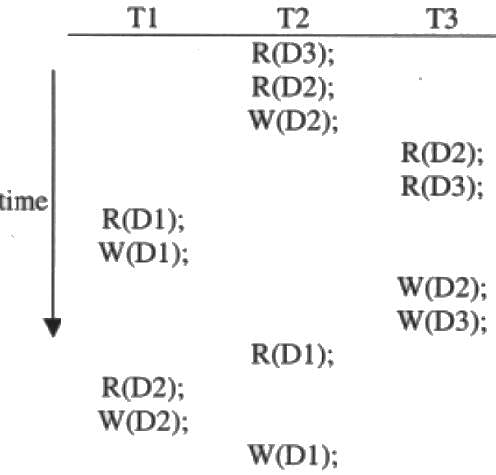Test: Transactions & Concurrency Control- 3 - Computer Science Engineering (CSE) MCQ
10 Questions MCQ Test - Test: Transactions & Concurrency Control- 3
Consider the following schedule for transactions T1, T2 and T3:

Which one of the schedules below is the correct serialization of the above?

Consider the following schedule S of transactions T1, T2, T3, T4:

Which one of the following statements is CORRECT?

| 1 Crore+ students have signed up on EduRev. Have you? Download the App |
Consider the following log sequence of two transactions on a bank account, with initial balance 12000, that transfer 2000 to a mortgage payment and then apply a 5% interest.
- T1 start
- T1 B old=12000 new=10000
- T1 M old=0 new=2000
- T1 commit
- T2 start
- T2 B old=10000 new=10500
- T2 commit
Suppose the database system crashes just before log record 7 is written. When the system is restarted, which one statement is true of the recovery procedure?
Consider three data items D1, D2 and D3 and the following execution schedule of transactions T1, T2 and T3. In the diagram, R(D) and W(D) denote the actions reading and writing the data item D respectively.

Which of the following statements is correct?
Consider the following transaction involving two bank accounts x and y.
read(x); x := x – 50; write(x); read(y); y := y + 50; write(y)
The constraint that the sum of the accounts x and y should remain constant is that of
Consider the following four schedules due to three transactions (indicated by the subscript) using read and write on a data item x, denoted by r(x) and w(x) respectively. Which one of them is conflict serializable.
Consider the transactions T1, T2, and T3 and the schedules S1 and S2 given below.
T1: r1(X); r1(Z); w1(X); w1(Z)
T2: r2(Y); r2(Z); w2(Z)
T3: r3(Y); r3(X); w3(Y)
S1: r1(X); r3(Y); r3(X); r2(Y); r2(Z);
w3(Y); w2(Z); r1(Z); w1(X); w1(Z)
S2: r1(X); r3(Y); r2(Y); r3(X); r1(Z);
r2(Z); w3(Y); w1(X); w2(Z); w1(Z)
Consider the given schedule and choose the suitable option.
S = T1:R(x), T1:R(y), T1:W(x), T2:R(y), T3:W(y), T1:W(x), T2:R(y)
Which of the following scenarios may lead to an irrecoverable error in a database system ?
Consider a simple checkpointing protocol and the following set of operations in the log.
(start, T4); (write, T4, y, 2, 3); (start, T1); (commit, T4); (write, T1, z, 5, 7); (checkpoint);
(start, T2); (write, T2, x, 1, 9); (commit, T2); (start, T3); (write, T3, z, 7, 2);
If a crash happens now and the system tries to recover using both undo and redo operations, what are the contents of the undo list and the redo list

















